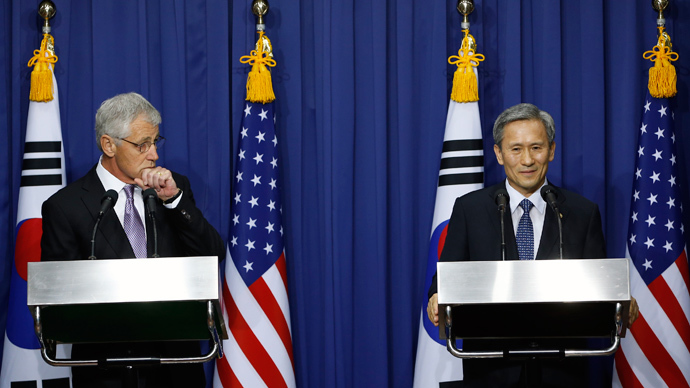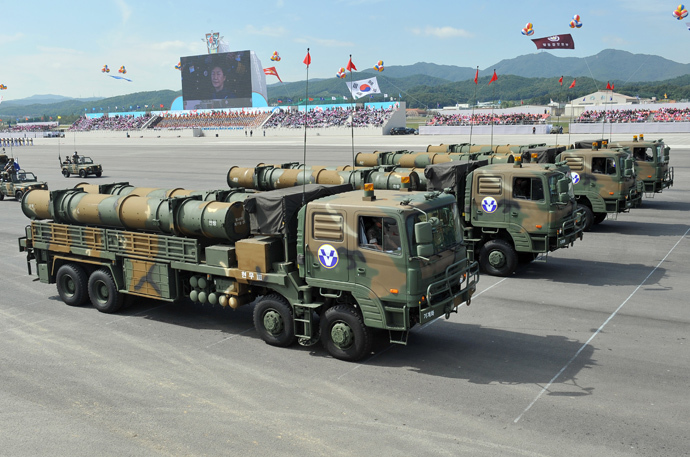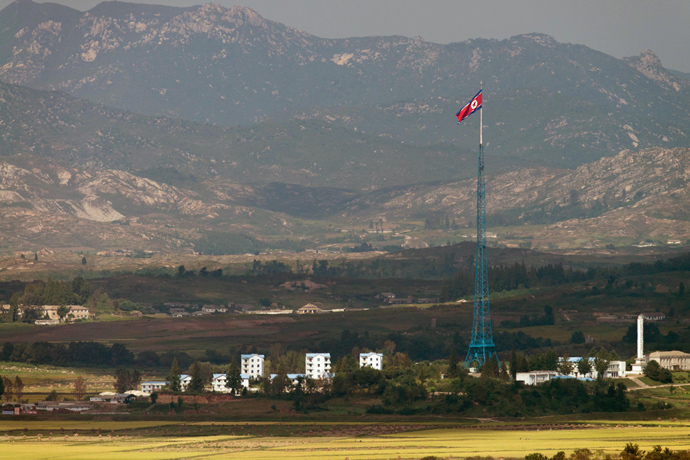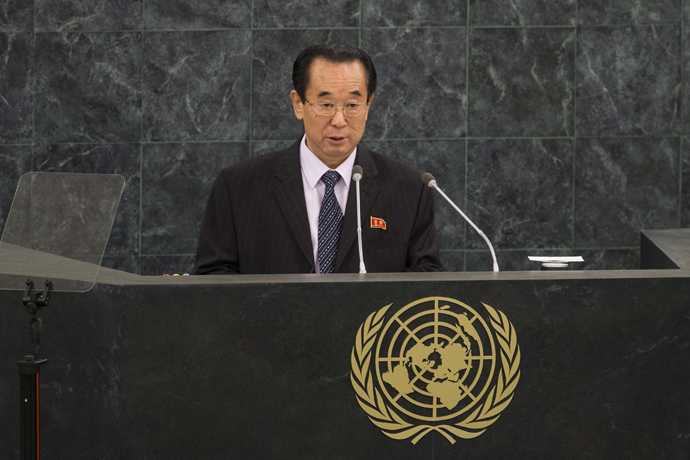No sunshine: Preemptive strike rationale deepens N. Korean status quo

Seoul and Washington have signed a new military pact that provides for carrying out preemptive strikes on North Korea, a move that will only deepen mutual distrust and damage inter-Korean cooperation.
In stark contrast to the hardline saber-rattling that ensued following Pyongyang’s third nuclear test in February, ties between the two Koreas have simmered significantly in recent months with the reopening of the joint Kaesong Industrial Complex in September after five months of closure.
Still, diplomatic exchanges always seem go nowhere, and often end in finger-pointing. Since coming to power earlier this year, South Korean President Park Geun-hye has further entrenched the policies of her deeply unpopular predecessor, Lee Myun-bak, with a harder military stance on Pyongyang. Seoul’s posturing recently culminated in a massive military parade showcasing homemade cruise missiles capable of hitting targets anywhere within North Korea, as well as Israeli-made Spike missiles that have been deployed right on the tense Northern limit line separating the two countries. Seoul plans to spend nearly $1 billion dollars on enhancing its missile defense capabilities over the next year.
Following a recent meeting between Chuck Hagel and the South Korea’s Defense Ministry, the so-called "Tailored Deterrence Strategy" has been rolled out, detailing the protocol for a preemptive strike on North Korea in the event of Pyongyang’s impending usage of WMDs.
According to the doctrine, Seoul can employ not only conventional strikes and missile defense capabilities, but also the American nuclear umbrella. Starting from 2014, the US Air Force will begin flying surveillance drones near North Korean borders to gather intelligence data.
Pyongyang hasn’t exactly applauded this news, and has fired back, promising to preempt any strike by attacking first. The scenario is a familiar one – Seoul and Pyongyang armed to the teeth, promising mutually assured destruction and war in one of the world’s most densely populated and economically productive regions.
Looking through the North’s eyes
Considering that North Korea is viewed as a belligerent and irrational actor, coupled with its self-imposed isolation, the views of North Korean people themselves are seldom taken into account in the outside world.
If these views were considered through the eyes of Pyongyang, they would be truly puzzled by the perception of “the North Korean threat” espoused by the West.
It would be irresponsible to dismiss the premise of the North’s tangible destructive capacity to the South, but in relative terms, Pyongyang’s aged military arsenal and nascent nuclear capability absolutely pales in comparison to the South’s sophisticated modern arsenal, America’s nuclear umbrella, and thousands of US troops just across the border.
The introduction of nuclear-capable B-52 bombers in joint military exercises earlier this year was perceived by Pyongyang as a dress rehearsal for a nuclear strike on the North. Not to mention the elaborate annual joint military drills that often see the firing of live rounds in disputed territorial waters.

To borrow John F. Kennedy’s terminology, the Korean Peninsula today lives under “a nuclear sword of Damocles, hanging by the slenderest of threads, capable of being cut at any moment by accident, or miscalculation, or by madness” – and it would be disingenuous to place the blame for this situation on a single actor.
North Korea’s shortcomings are highly publicized and well known to everyone, but it is logical that under the ever-palpable threat of destruction and conventional, missile, or nuclear first strikes, Pyongyang becomes more deeply-isolated and more inclined to act forcefully.
As Russian FM Sergey Lavrov alluded to in his recent UN speech, the unnecessary use of military force is counterproductive in that it works to promote the necessity of WMDs as a method of self-defense. It should be apparent that the approach taken by South Korea and the United States is clearly not the most effective method to address the inter-Korean problems – to the contrary – these tactics can hasten a deterioration of the situation with staggering consequences.
Imminent collapse?
The main component of Pyongyang’s foreign policy approach could be categorized as ‘survival diplomacy,’ whereby provocative language or actions are used for the dual purpose of staving off foreign military interference and positioning itself in negotiations for concessions.
While seemingly irrational, there is an element of careful Machiavellianism in these maneuvers that has prevented the situation from spiraling out of control. If one reads North Korean newspapers like the Rodong Sinmun and others, there is a noticeable focus on economic development that should not be overlooked by outside actors. Pyongyang’s central priorities are three-pronged; ensuring domestic political stability; modernizing its economy and military capabilities; and leadership survival.
Contrary to the predictions of doomsday analysts, North Korea is not on the verge of collapse; in fact its economy expanded for a second successive year in 2012 with GDP figures of 1.3 percent, a meaningful shift from its previous years of negative growth figures.

Despite being one of the world’s poorest countries, UNICEF reported in 2012 that chronic malnutrition levels in North Korea amounted to only 5 percent of the population, while 35 percent remain undernourished – these figures reflect the general standards of other Asian countries, with North Korea actually showing more favorable figures than countries like India and Indonesia.
After an assessment in 2010, the World Health Organization chief claimed that Pyongyang’s healthcare system has improved considerably to the past decade, and that its condition was something “most other developing countries would envy."
Although it officially denies having a network of gulags
throughout the country for political prisoners, recent reports by
human rights organizations put the number of inmates at somewhere
between approximately 80,000 to 120,000. If these reports are to
be believed, it would amount to roughly 0.08% of the population,
a reasonably low figure by international standards.
The need to compromise
Finding an answer to the Korean question will require ample flexibility by all sides, and requires adopting both new solutions and more vigorously reviving policies that have reduced tension previously.
There is tremendous potential for economic exchange between the two Koreas, and it would be in the interests of all players in the region to promote joint economic, manufacturing and industrial projects with North Korea. Of course, this would only be acceptable to Pyongyang with respect to its own terms and central objectives of sustaining the leadership.
Russia’s initiative to create an ‘Iron Silk Road’ connecting South Korea to the Trans-Siberian Railway through a border freight railway traversing North Korea is an example of a mutually beneficial project that helps improve Pyongyang’s infrastructure in the process. It’s clear North Korea would certainly like to channel more resources into developing its economy and national industries, but spending on military affairs takes priority for obvious reasons.
North Korea is the only state to have withdrawn from the Nuclear non-Proliferation Treaty (NPT) in open pursuit of nuclear weapons, in defiance of UN resolutions. If any possibility still exists for nuclear disarmament on the Korean Peninsula, it would have to come with major economic concessions, gradual disarmament, and a reduction of US troops in South Korea, which the North has repeatedly called for.
In a recent speech to the UN, North Korean Vice Minister for Foreign Affairs Pak Kil Yon maintained, “nuclear disarmament negotiations should commence without further delay to work on universal instruments legally codifying the negative security assurances and the prohibition of use of nuclear weapons.” Although the suggestion is seemingly at odds with North Korea’s nuclear ambitions at face value, this statement implies that some comprise is possible if compatible with Pyongyang’s central priority of leadership survival.

North Korea’s nuclear program is universally opposed, and China has recently banned a list of equipment and chemical substances for export to North Korea that can be used to develop a nuclear-capable ICBM. Beijing has also pushed for restarting the Six-Party Talks, which can serve a favorable function if North Korea can be convinced that its security and territorial integrity will not be infringed upon.
One of the most famous of the ancient Greek fables of Aesop tells
of a rivalry between the Wind and the Sun competing to make a
passing wanderer remove his cloak. When the Wind blew, the
wanderer only wrapped his cloak tighter, but when the Sun
glimmered and warmed the air, the wanderer found the coat to be
unnecessary and removed it. The superiority of persuasion over
force is a virtue worth remembering.
The statements, views and opinions expressed in this column are solely those of the author and do not necessarily represent those of RT.
The statements, views and opinions expressed in this column are solely those of the author and do not necessarily represent those of RT.













